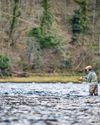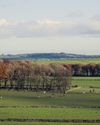
UNLESS they enjoy fishing, I doubt many motorists on the AI give the brown slick of tidal water stretching west from the bridge separating Gateshead from Newcastle upon Tyne a second glance. The river is a much grander sight a mile downstream where the parabolic arch of the famous Tyne bridge - built in 1928 - spans waters that have always been synonymous with a great northern city, epitomised by Lindisfarne's 1971 hit single Fog on the Tyne. The image of fog is redolent of the shipbuilding and heavy engineering that brought prosperity to Newcastle during the Industrial Revolution in the 19th century, but this progress marked the beginning of the end for the Tyne's migratory fish. By 1959 the situation was so dire that salmon were prevented in their entirety from accessing hereditary spawning grounds by an insurmountable barrier of filth, and not one was caught that year.
Since that lamentable nadir, the Tyne's gradual return to past glories is a gripping story of revival and restoration that began with the improvement of estuary water quality through substantial investment by water companies and government. The flooding of the North Tyne's headwaters and miles of valuable spawning burns to form Europe's largest artificial lake in 1981 could have set progress back to the 1950s - only it didn't, thanks in no small part to Peter Gray, who was the grandson of a Tweed boatman. Under Gray's direction the salmon hatchery established at Kielder Water to compensate for the catastrophic loss of habitat flourished to such an extent that when he retired in 2005 the annual rod catch stood at more than 4,000 salmon, and the Tyne's phoenix-like rise from the ashes was complete. Gray's illuminating story Swimming Against the Tide: Restoring Salmon to the Tyne was published in 2011, and the hatchery he founded continues to return many thousands of fry to the system each year.
This story is from the {{IssueName}} edition of {{MagazineName}}.
Start your 7-day Magzter GOLD free trial to access thousands of curated premium stories, and 9,000+ magazines and newspapers.
Already a subscriber ? Sign In
This story is from the {{IssueName}} edition of {{MagazineName}}.
Start your 7-day Magzter GOLD free trial to access thousands of curated premium stories, and 9,000+ magazines and newspapers.
Already a subscriber? Sign In

Rory Stewart - The former Cabinet minister and hit podcast host talks to Alec Marsh about the parlous state of British politics, land management and his deep love of the countryside
The gently spoken 51-year-old former Conservative Cabinet minister is a countryman at heart. That's clear: he even changes into a tweed waistcoat for the interview, which takes place at his London home and begins with a question about his precise career status. Having resigned from the Commons and the Conservative Party in 2019, the former diplomat and soldier has reinvented himself, first with an unconventional but promising run as an independent for the London mayoralty (abandoned because of COVID19 in 2020) and then as a media figure, co-hosting one of the country's most popular podcasts, The Rest Is Politics, alongside Alastair Campbell, the former Labour spin doctor.

Fodder
Local fare with the feel-good factor.

Celebrating the game changers
Once served only in the traditional manner, the fruits of our forays now find their way into all manner of diverse and delicious dishes, say Neil and Serena Cross

The first civil engineer
John Smeaton left an indelible mark on the field of engineering and, three centuries after his birth, his legacy remains as strong as ever

School spirits
From grey ladies and ghostly gardeners to more malign entities, public schools are a rich repository of unnatural phenomena

'A long way from Piccadilly or Pall Mall'
Marking 150 years since the birth of Sir Winston Churchill, Dr Conor Farrington explores this eminent statesman’s often-overlooked 1907 tour of British East Africa: a journey rich with enchanting natural beauty and sporting adventure

Top of the pups
Canines in all their guises were celebrated at The Field Top Dog Awards lunch at Defender Burghley Horse Trials whether eager on the peg, patient at home or perpetually making mischief

Angling for success
It’s never too early to shape up for next season’s salmon and trout, and these top fishing schools are here to help

Talking scents
The canine nose is an astonishingly complex piece of biotechnology that man has harnessed for sustenance and sport for thousands of years

Wall-to-wall excitement
Criss-crossed by formidable drystone walls, the High Peak Harriers’ scenic country provides a day out with an exhilarating difference